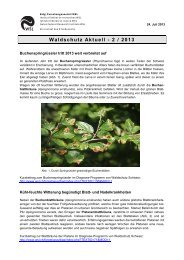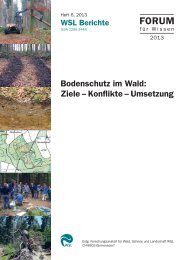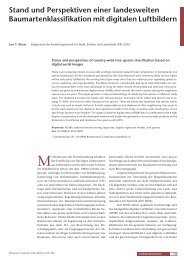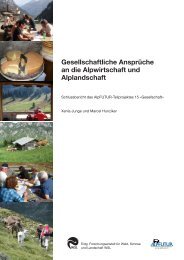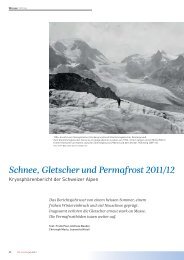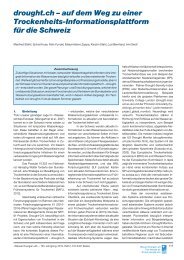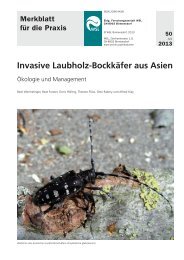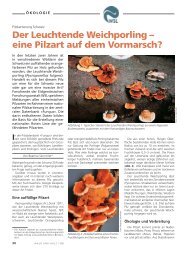Mycobiota of Castanea sativa Mill. in Azerbaijan - WSL
Mycobiota of Castanea sativa Mill. in Azerbaijan - WSL
Mycobiota of Castanea sativa Mill. in Azerbaijan - WSL
You also want an ePaper? Increase the reach of your titles
YUMPU automatically turns print PDFs into web optimized ePapers that Google loves.
406 Dilzara N. Aghayeva<br />
A dry<strong>in</strong>g process has been observed <strong>in</strong> chestnuts <strong>in</strong> forests, plantations and private plots <strong>in</strong><br />
the Great Caucasus. The <strong>in</strong>tensity <strong>of</strong> dieback is 45 to 50%. The purpose <strong>of</strong> this study was to<br />
<strong>in</strong>vestigate the mycobiota <strong>in</strong>volved <strong>in</strong> chestnut dieback.<br />
2 Materials and methods<br />
The fungi were isolated from dry<strong>in</strong>g chestnut trees <strong>in</strong> mixed forests or chestnut plantations that<br />
were 30 years old or older. Leaves, dead and liv<strong>in</strong>g branches and xylem from trees attacked by<br />
bark beetles were observed under the microscope (MBR-3). Specimens <strong>in</strong> which it was suspected<br />
that species <strong>of</strong> Ceratocystis were grow<strong>in</strong>g, but not yet sporulat<strong>in</strong>g, were placed <strong>in</strong> a damp chamber.<br />
Fungal isolations were made by transferr<strong>in</strong>g spore masses to MEA (20g malt extract, 20g agar per<br />
L water). Identification was made accord<strong>in</strong>g to POTLAYCHUK and SHEKUNOVA (1985). Mor -<br />
phological traits <strong>in</strong> culture, optimum pH and temperature optimum were determ<strong>in</strong>ed accord<strong>in</strong>g to<br />
BILAY and ELLANSKAYA (1982). The growth <strong>of</strong> the fungus was studied <strong>in</strong> liquid glucose-m<strong>in</strong>eral<br />
medium with the pH rang<strong>in</strong>g from 4.5 to 7.0 at 28 °C. The growth was measured by weigh<strong>in</strong>g the<br />
dry biomass. Optimum growth temperature was def<strong>in</strong>ed on MEA by measur<strong>in</strong>g the diameter <strong>of</strong><br />
the colonized area (<strong>in</strong> mm). The effect <strong>of</strong> humidity on the germ<strong>in</strong>ation <strong>of</strong> spores was studied<br />
accord<strong>in</strong>g to KHOKHRYAKOV (1976) <strong>in</strong> the exsiccator with humidities <strong>of</strong> 50, 60, 70, 80, 90 and<br />
100%. Spores on the dry glass slide were placed <strong>in</strong> the exsiccator at the optimal temperature <strong>of</strong><br />
28 °C. All experiments were performed three times. The carbohydrate and nitrogen requirements<br />
<strong>of</strong> the fungus were studied on Czapek’s agar (20g sucrose, 2g NaNO 3, 1g KH 2PO 4, 0.5g MgSO 4<br />
7H 2O, 0.5g KCl , 0.01 g FeSO 4 per L water) with a m<strong>in</strong>or modification (BILAY 1978): Sucrose was<br />
replaced by 20g maltose, glucose, cellobiose or cellulose each. 0.4% <strong>of</strong> NaNO 3, NH 4NO 3,<br />
(NH 4) 3PO 4, urea or asparag<strong>in</strong> were used as nitrogen sources. Media without any carbohydrate<br />
and nitrogen sources served as controls. The grow<strong>in</strong>g temperature was 28 °C.<br />
3 Results<br />
The first symptoms <strong>of</strong> chestnut dry<strong>in</strong>g appeared <strong>in</strong> June. Leaves became red, gradually<br />
turned yellow, dried out and fell <strong>of</strong>f. Dry<strong>in</strong>g began from the top <strong>of</strong> trees. At first th<strong>in</strong>, one to<br />
two year old summer branches died back, then the thicker branches. The process <strong>of</strong> dry<strong>in</strong>g<br />
spread down along the crown gradually. Dark brown l<strong>in</strong>es and dark or brownish wood<br />
elements were noted under the bark <strong>of</strong> the dry<strong>in</strong>g trees. Chestnut dry<strong>in</strong>g is chronic <strong>in</strong> nature<br />
and complete dry<strong>in</strong>g out <strong>of</strong> trees can be observed with<strong>in</strong> 4 to 10 years. This dry<strong>in</strong>g has been<br />
noted s<strong>in</strong>ce 1981 <strong>in</strong> Great Caucasus. The follow<strong>in</strong>g fungal species were recorded on the<br />
affected chestnut wood, twigs and leaves: Ceratocystis castaneae (Van<strong>in</strong> et Solov.) C.<br />
Moreau, Sphaeropsis castaneae Togn., Diplodia castaneae Sacc., Phoma endogena Speg.,<br />
Cyl<strong>in</strong>drosporium castaneae (Lev.) Krenner., Coryneum kunzei Cda., Cladosporium sp., and<br />
Mycosphaerella sp. Cryphonectria parasitca was noted only once <strong>in</strong> 1942 <strong>in</strong> <strong>Azerbaijan</strong>. S<strong>in</strong>ce<br />
then it has no longer been found (unpublished data).<br />
Ceratocystis castaneae was found under the bark <strong>of</strong> dry<strong>in</strong>g chestnuts <strong>in</strong> the Gabala forest<br />
for the first time <strong>in</strong> 1981 and aga<strong>in</strong> <strong>in</strong> 1994 (GUSEYNOV and AGHAYEVA 1997). S<strong>in</strong>ce 1994 it<br />
has been observed <strong>in</strong> other forests too (ma<strong>in</strong>ly <strong>in</strong> Great Caucasus). Perithecia develope<br />
abundantly on xylem. In culture, colonies are fast grow<strong>in</strong>g, cover<strong>in</strong>g a petri dish <strong>in</strong> 15 days at<br />
25 to 30 °C. In the beg<strong>in</strong>n<strong>in</strong>g the colonies are white, later becom<strong>in</strong>g white to grey. Both<br />
Sporothrix (Hektoen et Perk<strong>in</strong>s) and Graphium (Cda.) types anamorphs have been recorded.<br />
The conidiophores <strong>of</strong> Sporothrix anamorphs are clearly branched, hyal<strong>in</strong>e, septate, 33.6–47.6<br />
(42.9) x 2.5–2.8 (2.4) µm. The conidiogenous cells arise term<strong>in</strong>ally on conidiophores as<br />
sympodial denticles. Conidia are holoblastic, hyal<strong>in</strong>e, th<strong>in</strong>-walled, unicellular, oblong to<br />
ellipsoidal, clavate, 2.8–5.6 x 1.1–1.5 µm. They are formed s<strong>in</strong>gly, later becom<strong>in</strong>g aggregated<br />
<strong>in</strong> a slimy mass. The coremia <strong>of</strong> the Graphium type are brown, black, pale brown or subhya-



